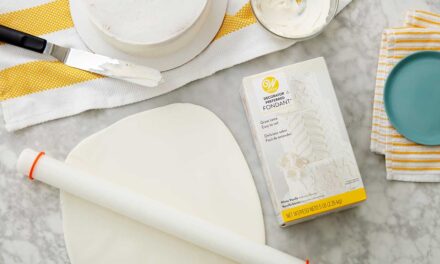If we had a nickel for every time someone asked us this question! This question may arise if you’ve ever baked a pie from scratch or made our buttercream frosting. We asked our test kitchen to give us the 411 on this mysterious ingredient.
What is shortening?
Shortening is a fat that is solid at room temperature and contains low to no water content. Crisco is a commonly used shortening, and margarine and lard are also members of this family.
Because shortening is made of 100% fat and contains no water, no steam is created during baking. This results in a dough that’s softer, flakier, and more tender. Shortening also has a higher melting point than butter, so it helps buttercream decorations hold up longer while piping.
Why should cake decorators use it?
People often ask why we recommend using a combination of shortening and butter in buttercream frosting rather than just butter. Here’s why:
- Butter imparts a yellow tinge when used in frosting, but has great flavor. Shortening allows you to achieve a clean, white color that serves as a perfect canvas for your artistry. The shortening and butter combination gives a whiter buttercream that still has great flavor.
- Shortening has a higher melting point, so your buttercream won’t melt as quickly when handling the piping bag. Decorations will be more stable in hot weather.
- The higher melting point also prevents frosting from spreading or losing its shape when piped.
- Shortening imparts a light and fluffy texture. Keep reading for a science lesson in how it manages to do that!
A Brief History of Shortening
Where did shortening come from? Hydrogenated vegetable oil was invented in the early 20th century. Since then, shortening has become almost exclusively synonymous with these fully saturated fats. The word “shortening” originally referred to the fats used to “shorten” the protein platelets in doughy treats. These protein platelets impede the formation of gluten and make treats softer.
What does this mean?
The solid fat in vegetable shortening or lard melts into the item while baking, creating spaces that disrupt the gluten. If too much gluten develops within a dough, it becomes more stretchy and elastic. Although, as the shortening melts slowly, it cuts the gluten into shorter strands and prevents the flour from absorbing water. It’s science!
Vegetable shortening was initially created in 1910 by Procter & Gamble as a cheaper alternative for lard and tallow*. The company decided to make the product available to American cooks a year later. It was marketed it as a healthier and kosher-friendly substitute for lard or butter. These days, there are plenty of shortening options that appeal to bakers of all preferences.
Shortening Baking Substitutions
Crisco is the most popular vegetable shortening choice on this side of the Atlantic, and UK bakers turn to brands like Trex, Flora White or Cookeen. Australians reach for Copha. Lard is the best substitute for those who don’t mind using animal fats in their baking. However, we don’t recommend it as a shortening substitute in buttercream frosting. Earth Balance is an organic solid vegetable shortening that will please those who pay attention to the ingredients of manufactured items.
In a pinch and can’t get to the store? Butter will certainly work as a substitute. When substituting with butter, use more butter than instructed and reduce the amount of water added to the baking mix. This will counteract the additional water content of the butter and help you achieve beautiful frostings, pie crusts, and other baked goods.





